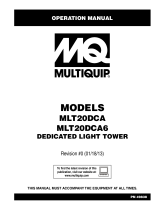
17
3. tIre Safety InformatIon
This portion of the User’s Manual contains tire safety
information as required by 49 CFR 575.6.
Section 3.1 contains “Trailer Tire Information”.
Section 3.2 contains “Steps for Determining Correct
Load Limit - Trailer”.
Section 3.3 contains “Steps for Determining Correct
Load Limit – Tow Vehicle”.
Section 3.4 contains a Glossary of Tire Terminology,
including “cold ination pressure”, “maximum ination
pressure”, “recommended ination pressure”, and
other non-technical terms.
Section 3.5 contains information from the NHTSA
brochure entitled “Tire Safety – Everything Rides On
It”.
This brochure, as well as preceding subsections,
describes the following items;
• Tire labeling, including a description and explanation
of each marking on the tires, and information about
the DOT Tire Identication Number (TIN).
• Recommended tire ination pressure, including a
description and explanation of:
A. Cold ination pressure.
B. Vehicle Placard and location on the vehicle.
C. Adverse safety consequences of under ination
(including tire failure).
D. Measuring and adjusting air pressure for proper
ination.
• Tire Care, including maintenance and safety
practices.
• Vehicle load limits, including a description and
explanation of the following items:
A. Locating and understanding the load limit
information, total load capacity, and cargo
capacity.
B. Calculating total and cargo capacities with varying
seating congurations including quantitative
examples showing / illustrating how the vehicles
cargo and luggage capacity decreases as
combined number and size of occupants’
increases. This item is also discussed in Section
3.
C. Determining compatibility of tire and vehicle load
capabilities.
D. Adverse safety consequences of overloading on
handling and stopping on tires.
3.1 traIler tIre InformatIon
Trailer tires may be worn out even though they still
have plenty of tread left. This is because trailer tires
have to carry a lot of weight all the time, even when
not in use.
It is actually better for the tire to be rolling down the road
than to be idle. During use, the tire releases lubricants
that are benecial to tire life. Using the trailer tires often
also helps prevent at spots from developing.
The main cause of tire failure is improper ination. Check
the cold tire ination pressures at least once a week for
proper ination levels. “Cold” means that the tires are
at the same temperature as the surrounding air, such
as when the vehicle has been parked overnight. Wheel
and tire manufacturers recommend adjusting the air
pressure to the trailer manufacturer’s recommended
cold ination pressure, in pounds per square inch (PSI)
stated on the vehicle’s Federal Certication Label or
Tire Placard when the trailer is loaded to its gross
vehicle weight rating (GVWR).
If the tires are inated to less than the recommended
ination level or the GVWR of the trailer is exceeded, the
load carrying capacity of the tire could be dramatically
affected. If the tires are inated more than the
recommended ination level, handling characteristics
of the tow vehicle/trailer combination could be affected.
Refer to the owner’s manual or talk to your dealer
or vehicle manufacturer if you have any questions
regarding proper ination practices.
Tires can lose air over a period of time. In fact, tires can
lose 1 to 3 PSI per month. This is because molecules of
air, under pressure, weave their way from the inside of
the tire, through the rubber, to the outside. A drop in tire
pressure could cause the tire to become overloaded,
leading to excessive heat build up. If a trailer tire is
under-inated, even for a short period of time, the tire
could suffer internal damage.
High speed towing in hot conditions degrades trailer tires
signicantly. As heat builds up during driving, the tire’s
internal structure starts to breakdown, compromising
the strength of the tire. It is recommended to drive at
moderate speeds.
Statistics indicate the average life of a trailer tire is
about ve years under normal use and maintenance
conditions. After three years, replacing the trailer tires
with new ones should be considered, even if the tires
have adequate tread depth. Some experts claim that
Tire Safety

























